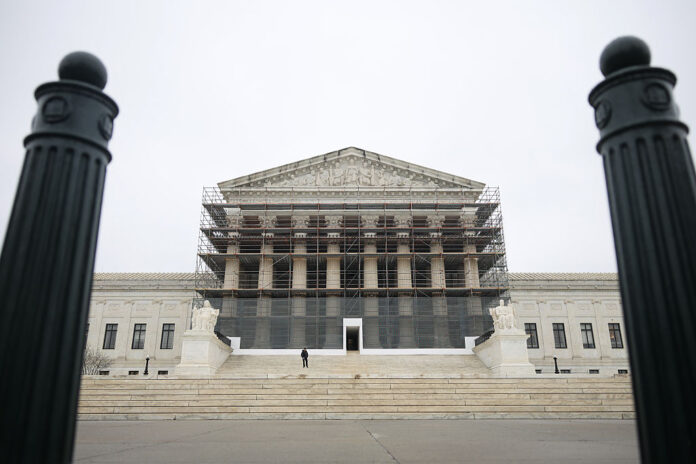In last term’s Trump v. CASA, the Supreme Court curtailed the use of universal injunctions – that is, lower court orders that grant relief to everyone, even people not involved in the case. On one view, this dramatically limited the ability of district courts to provide widespread relief to those affected by unlawful government policies. As has been recognized, however, CASA might not be nearly as consequential as it seems. This is because class actions may come to fill the universal injunction void. On that score, a coalition of states is now asking the court to address a question about class actions that could inform just how effective they can be as a substitute for universal injunction litigation.
Let’s start with a little background: In CASA, the court identified class actions as a procedurally permissible alternative to obtain relief for people who are not actively participating in a case. In a class action, what are known as “representative partiesâ€Â can litigate their own interests and on behalf of absent class members who share a similar claim or injury. So, if the government implements an allegedly unlawful policy, a plaintiff might be able to sue not only on her own behalf, but also as a representative of others to whom the policy applies (at least if the plaintiff checks the right procedural boxes under the Federal Rules of Civil Procedure). Once the court determines (or “certifiesâ€) that the case meets the criteria for a class action, it can enter an order that benefits everyone in the class, thereby granting relief to people not actively litigating the case – as was happening in pre-CASA universal injunction litigation.
A potential impediment to replacing universal injunctions with class actions, though, is that class actions come with their own host of complicated procedural intricacies. The case of Fitzhugh v. Patton, which the justices will decide whether to grant at conference on Nov. 21, may offer a glimpse into one such aspect of class-action litigation.Â
The big question in Fitzhugh is this: What happens to a class action if the named plaintiff loses their personal injury and has nothing left for the court to redress? To illustrate the problem, let’s use a simplified twist on the birthright citizenship issue in CASA. Suppose an undocumented pregnant woman whose child would be deemed ineligible for birthright citizenship under the president’s executive order files a class action on behalf of herself and all women in a similar situation. She asks the court for an injunction requiring the government to issue her child (and, by extension, the absent class members’ children) a Social Security card upon birth. A full-blown federal case will often take longer than nine months to litigate, so our plaintiff is likely to give birth before the case is over. If she does – and if the federal government issues her child a Social Security card – then she no longer has any personal stake in the case’s outcome. The government gave her exactly what she was asking the court to order. If there’s no injury of hers left to remedy, can the court nevertheless grant relief to everyone else in the class, which will still include pregnant women without the same certainty that their children will receive Social Security cards?
As it currently stands, and is often the case in the law, the short answer is “it depends.†Specifically, it depends on when the plaintiff lost her personal stake and where she happens to be litigating.
Take the timing issue first. Usually, when a plaintiff loses her personal stake in a case’s outcome before final judgment, federal courts treat the case as “moot†and must dismiss it without entering a ruling on the merits. But the mootness rule is riddled with exceptions, one of which applies to class actions.
Specifically, in the 1975 case of Sosna v. Iowa, the court held that a class action can proceed if a named plaintiff loses her personal stake in the outcome after a class has been certified. As alluded to above, certification is the formal process under the Federal Rules of Civil Procedure through which the district court defines which absent persons’ interests are included in the case and what issues the named plaintiff can seek to resolve on behalf of the class. As the court has emphasized, a certified class has its own “legal status†– separate from the named plaintiff’s – that allows it to move forward even if the named plaintiff has no ongoing legal interest in the case.
But what if the plaintiff loses her interest before the class is certified? Although the Federal Rules of Civil Procedure say that certification should occur at “an early practicable time,†there is no specific point at which it must happen in all cases. And in practice, there is often significant delay between the filing of a class-action complaint and the class’ actual certification. This is so because the requirements to certify a class are rigorous, so a court often cannot satisfy itself that a class is proper under the rules without allowing the parties to collect some evidence showing that the requirements are all satisfied. Here, too, the Supreme Court has provided some guidance: When the claims at issue are so “inherently transitory†that the named plaintiff’s claim will become moot before class certification can occur in the ordinary “pace of litigation,†a district court can still certify the class and allow the litigation to proceed.
Here is where the other “it depends†– the court’s location – comes into play. Some circuits hold that the class-action exception to the ordinary mootness rule applies only if the named plaintiff filed a motion requesting class certification before her claim became moot. Others disagree, holding that the filing of a class-action complaint can suffice to keep the case alive regardless of whether the plaintiff has moved for certification. This may sound highly technical, but the choice between these rules can be of great consequence, especially for cases (as in our birthright citizenship hypothetical above) in which the government can “pick off†the named plaintiff by just giving her what she wants – perhaps thereby preventing relief from issuing to everyone else in the uncertified class.
That’s where the petition in Fitzhugh v. Patton enters the picture. The case arose in Tennessee, where certain pre-trial criminal detainees must prove that the money being used to post bail is not derived from their criminal activity. Bradley Patton, a detainee subject to this rule, filed a class action in federal court on behalf of himself and all future detainees to challenge that rule as unconstitutional. He asked for an injunction against the rule’s future enforcement. The problem, though, was that he pleaded guilty to his crimes one week after filing suit, so he ceased being a pre-trial detainee with an ongoing interest in challenging Tennessee’s rule. When Patton lost his personal stake in the case, he had not formally moved for class certification, and no class had been certified. The district court dismissed his case as moot.
The U.S. Court of Appeals for the 6th Circuit reversed. Because pre-trial detention is inherently transitory (that is, it is always temporary), the court held that the filing of Patton’s class-action complaint was enough to keep the case alive even after his personal interest became moot. Tennessee, with amicus support from 21 other states, argues that this exacerbated an already deep split on the question of whether a pending class certification motion, or just the filing of the initial class-action complaint, is necessary to invoke the class action mootness exception. They further caution against a rule, like the 6th Circuit’s, that allows plaintiffs to keep litigation alive on the mere chance that they might someday file a class certification motion. Patton sees the case quite differently; he suggests, among other things, that the split mostly involves efforts to “pick off†particular plaintiffs by just giving them what they want (which is not his situation).Â
So to return to where we began: As more litigation shifts from seeking universal injunctions to seeking class-wide injunctions, knowing whether district courts can dismiss early-stage putative class actions if the named plaintiff’s claim becomes moot could increasingly matter. That is especially so when the government is in a position to strategically “pick off†a named plaintiff by giving her what she wants, in hopes that the entire case will be dismissed and that absent class members will not then seek their own relief. That would be the concern in the simplified birthright citizenship example above, in which the government might acquiesce to one plaintiff’s demands to try to erase her legal injury before she can move to certify a class that protects everyone else like her. As Fitzhugh shows, though, this same issue – plaintiffs’ losing personal stakes prior to certification – arises in litigation challenging an array of policies at the federal and state levels, including in cases that involve no strategic picking off at all. So this question is important and recurring all on its own.
For those interested in the fate of nationwide relief post-CASA, this is a petition – and an issue – worth watching.
Cases: Fitzhugh v. Patton
Recommended Citation:
Adam Crews,
States seek clarity on class actions in a post-CASAÂ world,
SCOTUSblog (Nov. 13, 2025, 10:00 AM),
https://www.scotusblog.com/2025/11/states-seek-clarity-on-class-actions-in-a-post-casa-world/





